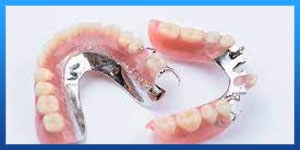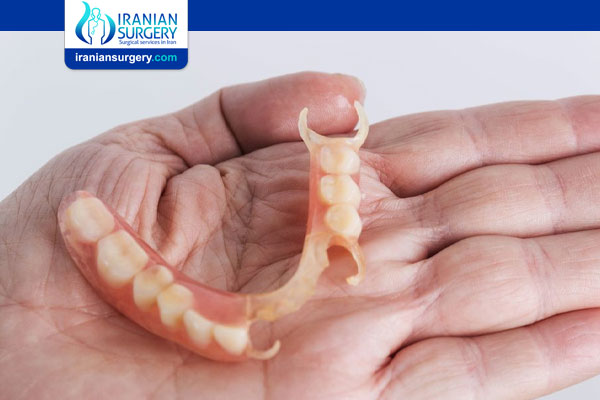Everything You Need to Know About Partial Dentures
. What are Partial Dentures?
. What are the Uses of partial dentures?
. What are the Types of partial dentures?
. How to choose the right partial denture?
Partial dentures can replace several missing teeth but not an entire upper or lower set of teeth. To get partial dentures, you must have some healthy teeth remaining in the upper and lower parts of your mouth.
What Are Partial Dentures?
Partial dentures are usually removable dentures that replace multiple teeth in the upper or lower portion of your mouth. Partial dentures are more than cosmetic devices. They can also enhance chewing and speaking for the wearer. Partial dentures can also preserve the placement of the remaining teeth in your mouth, which may otherwise shift over time.
Partial dentures aren’t usually intended for around-the-clock wear. Most dentists will recommend removing partial dentures at night and cleaning them.
According to a 2017 research review, cleaning partial dentures not only keeps them clean, but it also reduces the risk of developing cavities in nearby healthy teeth because you can brush around them properly.

The removable nature of partial dentures — as well as concerns over appearance and fit — can sometimes make them a less popular option.
The same research review above found that an estimated 39 percent of removable partial dentures were no longer in use 5 years after dentists produced them for patients.
Read more about : Cost of dental implants in Iran vs the USA
Why Would One Need Partial Dentures?
You may benefit from partial dentures if you’ve lost multiple teeth in the top or bottom of your jaw. Some contributing factors to a loss of your teeth include:
. injury
. removal of teeth or extraction
. decay
Whatever the reason, it’s important that your remaining teeth stay healthy. A dentist will construct the partial dentures, considering your remaining teeth. If these teeth are not healthy, a dentist may recommend extracting your teeth and utilizing full dentures instead.
What to Expect When Getting Partial Dentures:
. In the beginning, your new partial denture may feel awkward or bulky. This is normal, and you will eventually become accustomed to wearing it.
. Inserting and removing the partial denture will require some practice.
. Follow all instructions given by your dentist. Your denture should fit into place with relative ease. Never force the partial denture into position by biting down. This could bend or break the clasps.
. Your dentist will give you specific instruction about how long the denture should be worn and when it should be removed.
. Initially, you may be asked to wear your partial denture all the time. Although this may be uncomfortable at first, it's the quickest way to identify areas that may need adjustment.
. If the denture puts too much pressure on a particular area, that spot will become sore. Your dentist will adjust the partial denture to fit more comfortably. After making adjustments, your dentist will probably recommend that you take the partial denture out of your mouth before going to bed and replace it in the morning.
. Eating should become a more pleasant experience with dentures. Start out by eating soft foods that are cut into small pieces. Chew on both sides of the mouth to keep even pressure on both sides. Avoid foods that are extremely sticky or hard. You may want to avoid chewing gum during the adjustment period.
. Partial denture can also help improve your speech. If you find it difficult to pronounce certain words, practice reading out loud. Repeat the words that give you trouble. With time, you will become accustomed to speaking properly with your partial denture.
What Types of Partial Dentures Are Available?
Different manufacturing techniques and materials mean that there are a lot of partial denture options out there. The following are some considerations to know about partial denture types.
Read more about : Average age for dental implants
Location in your mouth
Partial dentures may replace the front (anterior) portion of your teeth or the back (posterior) portion.
In a 2017 study, people who had anterior partial dentures reported the greatest level of satisfaction. The researchers in the study above thought that the level of satisfaction might’ve been because the dentures made the greatest cosmetic difference for people’s smiles. But replacing the front teeth with partial dentures can also help people bite into foods more easily. Also, posterior dentures can aid in speaking and eating, which also enhances satisfaction.
Number of teeth on the dentures
Partial dentures aren’t the only option when it comes to replacing missing teeth. You may also choose full dentures, which replace an entire set of missing upper or lower teeth. If you have teeth remaining, your dentist will have to pull your teeth before you get full dentures.
Bridges are another type of replacement for teeth. They’re similar to partial dentures because they replace only a few missing teeth. However, bridges are usually present on one side of your mouth while partial dentures can replace teeth on both sides of your mouth. Also, bridges tend to be permanently glued in, while partial dentures are often removable.
Typically, a dentist will recommend partial dentures when you have three or more missing teeth that are next to each other.
Durability of Partial Dentures
A dentist may not always give you permanent partial dentures. Instead, you may have a temporary option. This is usually the case when your dentist has extracted damaged or decaying teeth that your partial dentures will replace.
According to the Oral Health Foundation, your gums need time to heal (usually about 6 months) after an extraction. After this time, your dentist can craft permanent partial dentures.
Read more about : One day dental implants
Materials used
For the base of the dentures, a dentist can use either plastic (resin) or metal, such as a mixture of cobalt and chromium.
. Metal: Dentists may make larger partial dentures with titanium. However, titanium caused inflammatory reactions in about 0.6 percent of people in a 2017 research review.
. Plastic and polymers: The Oral Health Foundation also emphasizes that bases made with plastic tend to be less expensive than those made from metal. This is because metal bases are lighter and more durable than plastic alternatives. However, plastic or polymer-based dentures have advantages as well, including:
. a desirable aesthetic appearance because no metal is visible
. easiness to make and repair
. lightweight and flexible
. Flexible dentures: Some people also choose another option for partial dentures called “flexible” dentures. These dentures are made from thin, lightweight thermoplastics and without visible metal clips. However, flexible dentures are usually bulkier than metal alternatives because they can break if they are made too thin, according to a 2014 research review.
Also, you’ll put in flexible dentures differently than the other types. Most metal- and plastic-based dentures are inserted directly into your mouth. With flexible dentures, you will usually warm the flexible dentures in water for a minute first to help the dentures better mold to your gums.
Attachments in your mouth
Dentists usually fit partial dentures with either clasps or precision attachments. Clasps are usually made from metal and will circle at least half of your adjoining teeth to partial dentures. Depending on where the clasps are placed, the metal may be visible when you smile. Precision attachments will attach onto existing teeth or dental implants. Dentists will customize precision attachments to each patient, including crowns to fit over existing teeth.
According to the American Dental Association, the extra work involved in crafting the attachments means they typically cost more than clasp attachments.
Caring for your dentures
. Your dentist can recommend a denture cleaner. Look for denture cleansers with the American Dental Association Seal of Acceptance.
. When cleaning a partial denture, it’s a good idea to stand over a folded towel or a sink of water just in case you accidentally drop the denture.
. Do not use toothpaste since it can be too harsh for cleaning dentures.
. Some people use hand soap or mild dishwashing liquid to clean their dentures, which are both acceptable. However, most household cleaners are too abrasive and should not be used for cleaning dentures.
. Brush the denture each day to remove food deposits and plaque. The helps the denture from becoming permanently stained.
. It's best to use a brush that is designed for cleaning dentures because it has bristles that are arranged to fit the shape of the denture. A regular, soft-bristled toothbrush is also acceptable.
. Avoid using a brush with hard bristles, which can damage the denture.
. Clean your dentures by thoroughly rinsing off loose food particles. Moisten the brush and apply the denture cleaner. Brush all denture surfaces gently to avoid damaging the plastic or bending the attachments.
. A denture could lose its proper shape if it is not kept moist. At night, the denture should be placed in soaking solution or water. Your dentist can recommend the proper method for keeping your dentures in good shape.
. Don’t chew, swallow, or gargle with denture cleansers.
. Always thoroughly rinse the denture before placing it in your mouth.
How Much Do Partial Dentures Cost?
Partial dentures vary in cost, based on a number of factors, including:
. materials used
. number of teeth replaced
. location in your mouth
. method of creating the dentures
You may also require dental care beforehand and denture adjustments after receiving your partial dentures.
How Do I Choose the Right Partial Dentures for Me?
A general dentist or a dentist who specializes in making dentures, called a prosthodontist, will create your partial dentures. When doing so, they take several factors into account, such as:
. anatomy of your mouth, including your hard and soft palate
. your remaining teeth and how they fit together
. your cosmetic goals
When considering the type of partial dentures you would like, ask yourself the following questions:
. What allergies do I have? People with metal or acrylic allergies may need to wear flexible dentures.
. Do I mind if someone sees metal clips for my partial dentures? If your missing teeth are in the back of your mouth, this factor may be less important. For front teeth, you may prefer acrylic or precision attachments.
. How much can I reasonably afford to pay for partial dentures? Cost is an important factor in getting dentures that meet your needs but don’t break the bank.
Your dentist or prosthodontist can also help you make the right choice when it comes to the best partial dentures for you.
Source:
https://www.healthline.com/health/dental-and-oral-health/partial-denture



6 Comments
What happens if the implant fails and the tooth is left empty?
Empty teeth causes bone loss and lateral tooth movement causes food to stay between the teeth and tooth decay. And if the tooth bone is completely destroyed, even implant treatment may be difficult or even impossible.
is smoking really a failure of dental implant treatment? Does it mean that cigarettes should not be implanted?
hello Naeem, Smoke harms the surrounding gums and bone: Cigarette smoke burns the oral tissues on the inside of your mouth, and it can even damage or block the salivary glands, which results in mouth dryness. A lack of saliva can lead to tooth decay and gum disease — weakening the bone and gums that support your implants.
I have irregular teeth, which one is the best choice? orthodentic, laminet or composite veneer?
hello, it depends on the shape of your teeth, please take some photos of your teeth and send them to my whatsApp number, so I can provide you with more accurate information. This is my whatsApp number +989019290946. Thank you